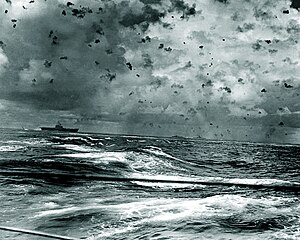1942 ⟶ Battle of Santa Cruz: Japanese Carrier Losses
The naval Battle of Santa Cruz. The Japanese lose many aircr...Year
1942
1943
🚢 Battle of Santa Cruz: Japanese Carrier Losses
The naval Battle of Santa Cruz. The Japanese lose many aircraft and have two aircraft carriers severely damaged. USS Hornet is sunk and USS Enterprise is damaged.⟶

Pacific TheaterNaval BattleAircraft CarriersUS NavyJapanese NavySanta CruzWarshipSinking
💥 Battle of Midway: Day 1 - Japanese Carriers Crippled
A good deal of damage is done and many aircraft destroyed on both sides, but in the end the island's airbase is still functional. Nagumo plans a second attack on the island, and begins refueling and rearming his planes. Meanwhile, attacks are launched from all three American aircraft carriers in the area. Planes from USS Hornet, Yorktown, and Enterprise all find the targets, although most of the planes from Hornet follow an incorrect heading and miss this attack. Torpedo Squadron 8 from Hornet breaks and follows the correct heading. The Devastators of "Torp 8" are all shot down without doing any damage; there is only one survivor, George H. Gay, Jr. of Waco, Texas, who watches the battle unfold from the water. The torpedo attack fails, but draws the Japanese Combat Air Patrol down to low altitude, and they are unable to effectively repel the dive bombers from Yorktown and Enterprise when they arrive. The bombs find the Japanese flight decks crowded with fueling lines and explosive ordnance, and Akagi, Kaga, and Soryu are all soon reduced to blazing hulks, Akagi hit by only one bomb dropped by Lt. Commander Richard Halsey Best; only Hiryu escapes with no hits. Admiral Nagumo shifts his flag from Akagi to another ship, the cruiser Nagara, and orders attacks on the American carriers, one by a group of Aichi D3A dive bombers and a second by Nakajima B5N torpedo bombers. The Japanese planes find Yorktown (thinking Yorktown already sunk, the second attack group assume it must be Enterprise) and damage it so badly that Yorktown must be abandoned. Admiral Fletcher shifts his flag to cruiser Astoria and cedes operational command to Admiral Spruance. The attacks on Yorktown give away Hiryu's continued operations, though, and it is promptly attacked and will sink the next day, Admiral Yamaguchi choosing to go down with it. Of note, Hiryu and the other three destroyed Japanese carriers had participated in the attack on Pearl Harbor.⟶

Pacific TheaterNaval BattleAircraft CarriersDive BombersTorpedoesUS NavyJapanese NavyAir CombatTurning Point
🚢 Battle of Midway Ends: Japanese Fleet Devastated
The Battle of Midway comes to a close; USS Yorktown sinks; four Japanese carriers and one cruiser are sunk. The battle is viewed as a turning point in the Pacific war.⟶
Pacific TheaterNaval BattleAircraft CarriersUS NavyJapanese NavyTurning PointWorld War IIMilitary StrategyIsland Hopping
🛳️ Naval Battle of the Eastern Solomons
The naval battle of the Eastern Solomons; USS Enterprise is badly damaged and the Japanese lose one light carrier, Ryujo.⟶
Eastern Solomonsnaval battleUS NavyJapanese Navyaircraft carrierUSS EnterprisePacific TheaterWorld War IISolomon IslandsAsia
🪦 Battle of Guadalcanal: USS Hiei Sunk and USS Juneau Sunk with Sullivan Brothers
Battle of Guadalcanal: aviators from USS Enterprise sink the Japanese battleship Hiei. Notably, USS Juneau is sunk with much of its crew, including the five Sullivan brothers.⟶

GuadalcanalNaval BattlePacific TheaterUS NavyJapanese NavySolomon IslandsSinkingBattleshipUSS JuneauWarfareUS
🚢 Battle of Kula Gulf in the Solomons
U.S. and Japanese ships fight the Battle of Kula Gulf in the Solomons.⟶

Pacific TheaterBattle of Kula Gulfnaval battleSolomon IslandsUS NavyJapanese Navy